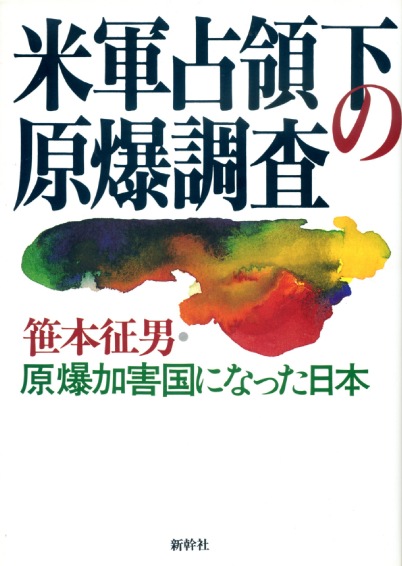Sasamoto, Yukuo. 笹本征男. 1995. Beikoku senryôka no genbaku chôsa—Genbaku kagaikoku ni natta Nihon. 米軍占領下の原爆調査―原爆加害国になった日本 [Atomic Bomb Surveys Under American Occupation: How Japan Became a Nuclear Aggressor]. Shinkansha. 新幹社.
 原爆投下から原爆医療法ができるまでの期間は被爆者にとって暗黒の十年であったといわれる。このうち七年間、日本はアメリカ軍に占領されていた。本書はこの時期に何があったのかを被曝者を対象とした原爆調査の歴史から検証し、原爆加害国であるアメリカに協力していった原爆被害国日本の加害性を問うものである。
原爆投下から原爆医療法ができるまでの期間は被爆者にとって暗黒の十年であったといわれる。このうち七年間、日本はアメリカ軍に占領されていた。本書はこの時期に何があったのかを被曝者を対象とした原爆調査の歴史から検証し、原爆加害国であるアメリカに協力していった原爆被害国日本の加害性を問うものである。
本書においては日本とアメリカの被爆者調査が何を目的としていたのか、日米がどのように調査協力していったのか、実際にどのような原爆調査が行われたのか、等詳細な検討がなされる。その上で著者は、妊産婦と新しく生まれてきた乳幼児に対して徹底的な調査が行われたこと、また史上例をみない規模で人間集団を対象とした(原爆投下を受けていない都市を比較対照とした)比較対照実験が行われたことを強調する。かつてない「原子力時代」に突入した時、広島、長崎の被爆者は格好の調査材料とされ、日米両国に利用されたのである。
3月11日の地震とそれに伴う原発災害により、地球上に生きている私たちは「原子力時代」に生きていることを唐突に再認識させられることとなった。低線量被曝の問題は今日の日本メディアの主要な関心となっているが、その裏には調査材料とされデータを提供することになった多くの核時代の犠牲者たちがいたことを忘れてはならない。本書は、「今の時代はまさに「来てしまった平和な『原子力時代』」である。そこに生きる私たちの存在が問われているのである」と結ばれている。
The years it took to develop medical treatment for radiation amounted to a “decade of darkness” for Japanese victims of the atomic bombing. For seven of these years, the American army occupied Japan. This book launches its inquiry into what happened during those years from the history of atomic bomb surveys that objectified victims, and ultimately questions the potential aggression of Japan, a nation that was both a victim of the atomic bomb and a cooperator with the U.S., a nuclear aggressor.
What were the objectives of Japanese and American surveys of the victims? How did they cooperate with one another? What kinds of atomic bomb surveys were actually conducted? The book examines these and other questions in detail. In addition, the author emphasizes that there was a rigorous investigation of pregnant women, nursing mothers, and newly born infants, and that among experiments involving human subjects, this was one of an unprecedented scale, using inhabitants of cities that had not been bombed as objects of comparison. When the world leaped into the new “atomic age,” the victims in Hiroshima and Nagasaki were rendered into material that could be researched by both Japan and the U.S.
The earthquake and resulting nuclear disaster on March 11th have come to bear a painful reminder to people all over the world that we live in the atomic age. The problem of low-dose radiation exposure remains a major concern of the Japanese media now, but we should not forget that behind this issue lie the many victims of the nuclear age who provided data and became material for research. The book concludes, “This peaceful ‘atomic era’ in which we have ended up calls to question our very presence in it.”
For information regarding the American investigation of effects of the bombing, see Lindee, M. Susan. 1994. Suffering Made Real: American Science and the Survivors at Hiroshima. University of Chicago Press.
– Maika Nakao, with English translation by Jennifer Lillie
![[Teach311 + COVID-19] Collective](https://blogs.ntu.edu.sg/teach311/files/2020/04/Banner.jpg)